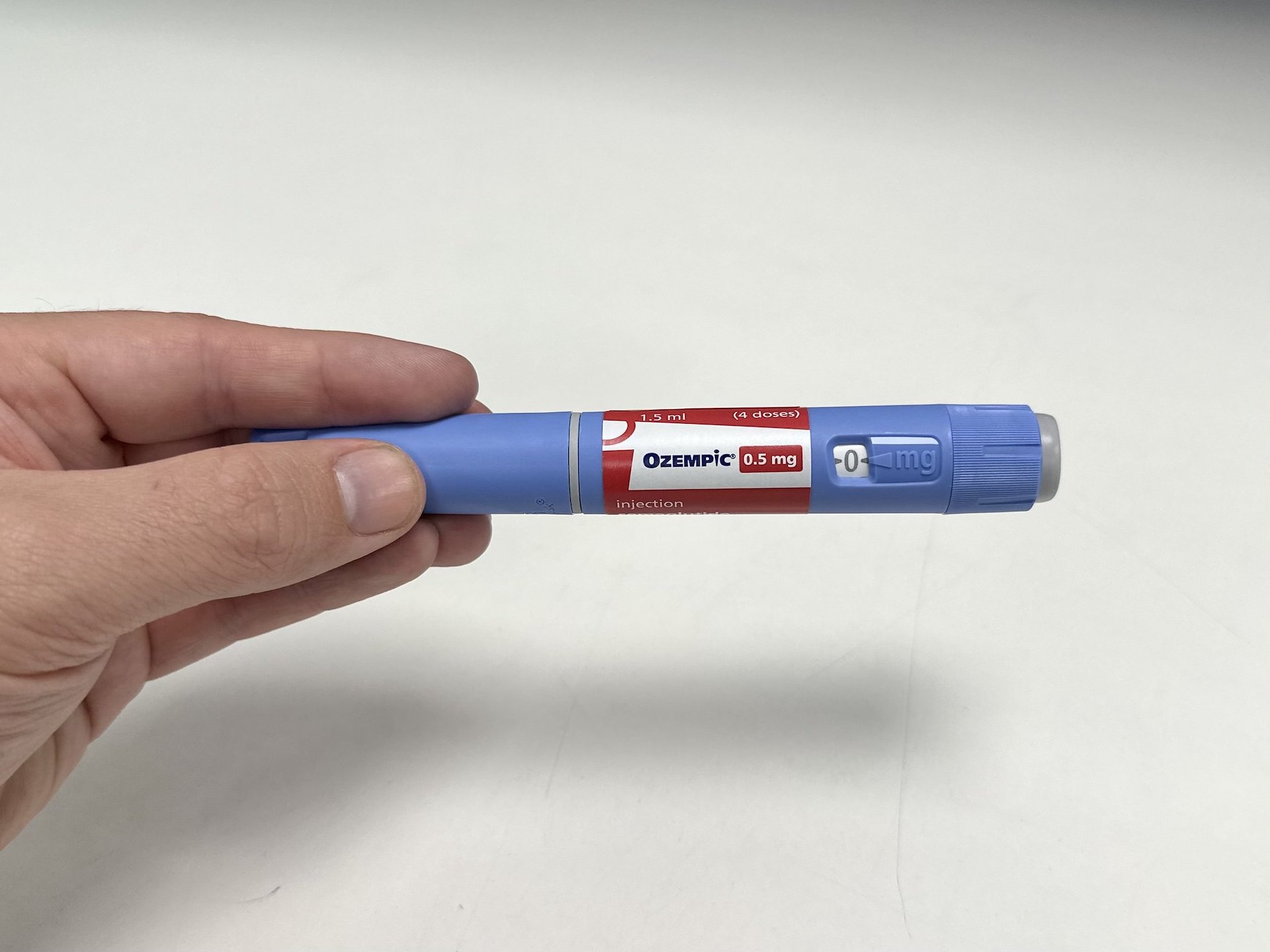It’s an economic, social and cultural phenomenon. An open secret among the rich and famous, the basis of a new South Park special, and the driver behind pharma giant Novo Nordisk’s rise to become the highest-valued company in Europe. Ozempic and Mounjaro (made by competitor Eli Lily), and the family of related drugs known as GLP-1 and GIP/GLP-1 agonists, were developed for managing Type 2 Diabetes, but soon became known for their significant effects on appetite suppression and weight loss.
For decades, pharma companies have been searching for the commercial holy grail: a drug that is both safe and effective for weight loss. Many contenders have entered the arena, but none survived long term. Enter these drugs, with additional varieties like Wegovy (the same drug as Ozempic but in a slightly higher dose) now approved for weight loss specifically.
Such is the demand, worldwide shortages of semaglutide (the generic name for Ozempic and Wegovy) left people with Type 2 diabetes unable to access the medication their doctor prescribed. In some countries, this led to a restriction on prescribing it for people without diabetes. What happened next was exactly what you’d expect. Fueled by blockbuster demand that couldn’t be met, compounding pharmacies began taking matters into their own hands, allegedly mass-producing the drug. In some cases, copycat versions of the drug were allegedly produced, in sub-standard conditions, sold online and shipped around the world.
What does this all have to do with cycling? Well as the saying goes, sport reflects society, and over the past year some members of the Escape Collective team have become aware of significant use of these weight-loss drugs in (non-professional) parts of the cycling community. With the allure of easy weight loss in a sport that’s weight-sensitive when the road starts to incline, and that places a high value on the stick-thin physique of many of its global superstars, it’s not surprising that Ozempic, Wegovy, Mounjaro, and related drugs would turn up in our sport.
For those not familiar, these are injectable medications, taken in a similar way to insulin. The early GLP-1 agonists appeared in the mid-2000s and had to be taken twice a day for diabetes management. Extended-release versions followed, and in 2017 semaglutide (i.e. Ozempic) entered the market as a weekly injection. If you’re wondering whether these drugs are banned substances from a sporting perspective – they’re not. However, the No Needle Policy of the UCI and other organizations prohibits injections without a clear medical justification. But as you’ll soon see, there are plenty of reasons elite and professional athletes aren’t going to be tempted by them anyway.
This group of medications work by mimicking the action of glucagon-like peptide 1 (GLP-1), and/or glucose-dependent insulinotropic peptide (GIP). There are multiple effects of these peptides, including lowering blood sugars which was the intended use for diabetes. But in addition, GLP-1 slows the emptying of food from the stomach, which will make you feel full sooner, and for longer. It’s also believed there’s a broader effect on appetite suppression, most likely in the brain, although exactly how and why isn’t completely understood. GIP reduces the production of stomach acid, which also slows down the initial steps of digestion in the stomach. It also makes the body more sensitive to insulin, having an additional effect on lowering blood sugars, and may interact with body fat cells themselves.
We spoke to an Escape Collective member who wished to remain anonymous, who tried Ozempic for a few weeks. They ordered it from an online pharmacy in Australia. “I just filled out some info on the website, lied about my BMI (they want to see something upwards of 26 [which classifies someone as ‘overweight’ – ed.]), a ‘doctor’ called me for about 60 seconds, and then the box was in the mail”. The effect of appetite was noticeable immediately: “It definitely suppressed my appetite, in a really good way actually. I comfortably ate about ~2,000 calories a day, felt satisfied, and I still enjoyed food. I only lost about 2-3 kg (in 2-3 weeks), but I could definitely tell in the mirror a difference in my body fat. I also kept up weightlifting a couple days per week as I was conscious about muscle loss”.
This description certainly fits with the research, which shows that GLP-1 and/or GIP agonists have effects on body weight that are greater than lifestyle changes alone, but not as effective as bariatric surgery. But buyer beware: it’s not a one-and-done solution. When users stop taking the drug, they tend to regain most or all of the weight they’d lost.


While the weight-loss effects of Ozempic, Mounjaro and related drugs are undeniable, as with all pharmaceuticals there’s a trade-off. The officially reported, common side-effects for both drugs include gastrointestinal issues like nausea, vomiting, and diarrhoea, although it is believed that these are most severe when first taking the medication, and decline after a while. Like any injection, there’s also a risk of infection around the injection site, and a risk of developing a hardened, fatty lump under the skin if using the same place on the body each time.
Acute pancreatitis is a more-serious, but less-common side-effect. Other reports from users of the drug have included depressed mood, in some cases severely so. That’s for the genuine product. Reports compiled from people taking poorly compounded versions of the drugs have included a range of other side-effects. Both the officially recognized and patient-reported side-effects may be a major reason why a large proportion of people who start Ozempic stop within the first four weeks, especially those users who were not under the regular care of a specialist physician.
As a cyclist, you can imagine that gastrointestinal side-effects are not going to be conducive to high-level performance. Even if these subside after a few weeks, for cyclists doing large volumes of training, a drug that makes it harder to provide your body with the fuel it needs is clearly going to be performance-limiting, not enhancing. When you’re burning thousands of calories a day on a regular basis, a pharmaceutical appetite-suppressant is not a great strategy.
But is there a place for these medications in the non-elite cyclist? I’m not a medical doctor, and this isn’t medical advice, so from a purely health perspective that’s not for me to answer. As for our Escape member, here’s their experience when it came to combining Ozempic with exercise: “What it also did was prohibit any performance whatsoever (my legs burned after about five hard pedal strokes), gave me pretty depressing mood swings, and had pretty bad gut issues that felt like gastro (but would pass by the next day)”.
To what extent these side-effects would subside with time is hard to say, but others have noted that the pharmacological suppression of appetite also takes the enjoyment out of eating, which may be a real downer for those who live to eat, and not eat to live. On balance, the negatives outweighed the positives for our Escape member, and they joined the large number of Ozempic users in stopping the medication in the first month.
“The thing I learned was that I would much prefer to ride and exercise at my own good level (relatively speaking), rather than the huge performance-limiting impediments that semaglutide created,” they said. “I figured I could pause the intensity and just ride easily while I took off the weight, but even that proved to be so uncomfortable I almost quit exercising altogether. For sedentary people, I can see how this would be an attractive means to lose weight. (But for me) the discipline and discomfort of eating well is so much better and worthwhile than the side-effects of this drug”.
Perhaps the most striking thing when discussing this with the EC team was where they were seeing these medications being discussed in the cycling community. It wasn’t the recreational cyclist with a family history of heart disease or diabetes. And it wasn’t the elite and professional riders. It was predominately the Masters cyclists who used to race competitively, but with age, work, and family responsibilities, no longer ride as much or to the same level as before. They’re still quite healthy compared to their peers, and not overweight by any definition of the term, but they no longer “look like a cyclist”. It seems that those most interested in weight-loss drugs within the cycling community are those who refuse to take the transition from Masters to MAMILs lying down. Everyone has an ego.


We’re all Escape Collective members because we love riding bikes, and we love the sport of cycling. But it’s a fine line between cycling being a favourite pastime, and it being core to your identity. What makes matters worse is that the figures standing atop the pedestal we so often place our champions on, have a razor-thin silhouette. We ride around in close proximity, wearing figure-hugging lycra, and conversations can easily turn to the size and shape of people’s bodies. We casually throw around phrases like “eating’s cheating”, and when someone has visibly lost body fat, we comment “they look fit”. It’s hardly surprising that negative body image and disordered eating are rife amongst cyclists.
Almost 80% of cyclists surveyed, ranging from club to international level, reported attempting weight loss for their sport in the past year. But sometimes the leanest riders in the bunch aren’t the fittest and healthiest – they’re the riders suffering in silence; their food, their sport, and their life all-consumed by an eating disorder.
What is it going to take for cyclists to feel better about their bodies, and not feel the need to look for pharmaceutical solutions to problems that are nothing to do with health and everything to do with appearance? This certainly isn’t a problem unique to cycling, but there are a bunch of additional factors in our sport that don’t help. We need to remind ourselves that the top riders in the world are different from the rest of us, both in terms of their ability to turn food into watts, and in their body composition. There’s only a small handful of people that can achieve that physique without compromising their health and performance, and weight-loss drugs aren’t going to change that.
We also need to improve the culture within the cycling community. Comments about people’s bodies, in person or online, matter. Whether it’s admiration of the pros or condemnation of others in your local bunch, these comments all contribute to poor body image. Phrases like “eating’s cheating” might sound like just a bit of fun, but they have their way of seeping into our subconscious, invoking guilt and shame for many when it comes to food. Even positive comments like “wow, you’re looking in great shape” may be well-intentioned, but can serve to endorse someone’s restrictive or unhealthy eating practices, and in some cases, the choice to turn to weight-loss drugs to fit in with the bunch.
Just because someone else isn’t fueling their ride or getting stuck in at the café afterwards doesn’t mean you shouldn’t. Maybe you’ll be the positive example they need to encourage them to fuel better too. Compliment fellow riders on their watts, their bike-handling skills, or their etiquette out on the road, but never on their weight, their body, or their eating habits.
Ultimately, the demand for Ozempic and other weight-loss drugs within the cycling community isn’t necessarily greater than in society as a whole. But it does shine a light on the social and cultural aspects of our sport that might contribute to body dissatisfaction, mental illness, and the consequences. Of course there are plenty of people with diabetes or other health concerns who also ride bikes, and I don‘t want to delegitimise their use of these medications, or the advice of their doctors. But that’s a very different story to ordering drugs of unknown quality online, with little to no medical advice, all in pursuit of “looking like a cyclist”.
If you ride a bike, you’re already a cyclist. That should be good enough.
What did you think of this story?

Sarah Carter is a health and wellness expert residing in the UK. With a background in healthcare, she offers evidence-based advice on fitness, nutrition, and mental well-being, promoting healthier living for readers.







